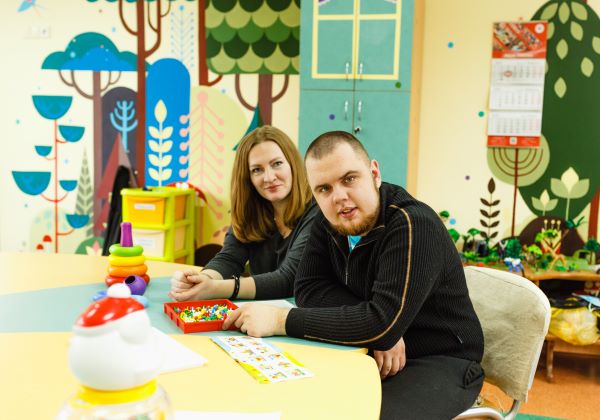Putting the Person First
What exactly is “Intellectual/Developmental Disability,” commonly abbreviated as I/DD or IDD?
Before I answer that question, let’s consider some more “alphabet soup.” For example, what do these terms mean: MR, IQ, DD, CP, FAS, SQ, ADHD, ADA, and DS? And what is a percentile, a standard deviation, and a normal curve? And what does NC-SNAP have to do with all of this?
I’ll answer each of these questions, because it’s worth knowing what these terms mean in order to understand what “I/DD” means. But it’s much more important to understand that what really matters is that people with I/DD are people first, with their own unique characteristics, strengths, challenges, friends, and families.
The “alphabet soup” that is often used to describe and even define what I/DD means often has the effect of diminishing the value and human-ness of the people who are labeled. This is not meant to minimize the importance of understanding the technical definitions or the importance of having a fair and equitable way of understanding differences in people who are considered to have I/DD. But the reality is that definitions and labels regarding “I/DD” have changed drastically over the years, as have our expectations and beliefs about what people with I/DD can do, the rights they have, the extent to which they can make their own decisions and advocate for themselves, and the extent to which they are fully integrated into our society.
Therefore, as you read the material below, please keep in mind that people with I/DD are people first, and that the labels used to define them are only a dim reflection of the value and worth of the people themselves.
This blog covers the following topics:
- The history of IDD
- What is Intellectual/Developmental Disability (I/DD)?
- Prevalence of I/DD in the United States
- Causes of Intellectual Disability
- I/DD Symptoms
- Treatments, Supports, and Resources for I/DD
The History of I/DD Labels

In the past, people who are described today as “I/DD” were described in many other ways, sometimes in terms that are considered pejorative today. Not many decades ago, the term “developmental delay” or “DD” was prevalent. Before that, “mental deficiency” was a term widely used. “Mental retardation” was also used, and “people with mental retardation” were typically sub-divided into mild, moderate, severe, and profound levels of mental retardation.
Diagnostic labels included “moron,” “imbecile,” and “idiot,” depending on the perceived extent of the person’s intellectual challenges. Remember, these terms were officially used by medical and other professionals; they were not meant to be insulting terms, the way some people use them today. In fact, as noted in an article on the North Dakota Center for Persons with Disabilities (NDCPD) web site, these terms, “did not strike these medical officers as insulting or offensive at all because, at the time, they weren’t insulting or offensive. They were simply medical terms. In fact, “moron” was a new word invented by Henry H. Goddard, a psychologist who helped devise the American version of the IQ scale and the three classifications adopted by the group.”
More information about the history of terminology used to label people who we now describe as intellectually disabled is included in this article, also available via the NDCPD web site.
An interesting reflection on the way labels and concepts have changed regarding people with I/DD is the way that the largest professional I/DD organization in the United States has changed its name over the years. Early in my career (in the 1970’s), I joined the American Association on Mental Deficiency. They later changed their name to the American Association on Mental Retardation, and then (currently) to the American Association on Intellectual and Developmental Disabilities.
These changes reflect a shift in the way “I/DD” is understood and, more importantly, a shift in the resources available to people with I/DD, and how those people are integrated into families, schools, and communities.
What is Intellectual/Developmental Disability (I/DD)?

The term I/DD, or Intellectual/Developmental Disability, encompasses many different conditions, all of which affect a person’s ability to learn and to function in society on a day-to-day basis.
I/DD includes two similar but not identical groups of conditions: intellectual disability and developmental disability. The term developmental disability is a broader term than intellectual disability. It includes intellectual disability, but also conditions such as Attention-Deficit Hyperactivity Disorder (ADHD), learning disabilities (such as dyslexia or auditory processing disorder), and some physical conditions such as cerebral palsy (CP).
Intellectual Disability Criteria
Intellectual disability specifically refers to individuals with documented cognitive limitation or impairment, and limited ability to complete at least three activities of daily living independently. The word “and” is a very important word in this definition, because it’s easy to focus only on the “documented cognitive limitation or impairment” part of the definition, and in the past, the presence of functional limitations was not considered.
Today, both parts of the definition are required, because the importance of the ability to function in daily life is recognized. Related to this is a recognition that understanding the types and levels of supports and resources that a person needs in order to be able to function as independently as possible is as important – or more important – than simply labeling someone as having an I/DD.
The Family Support Network gives a very succinct description of the difference between developmental disability and intellectual disability.
Prevalence of I/DD in the United States

How many children in the U.S. have an Intellectual Disability?
Most estimates are that between 1% and 3% of children in the United States have an intellectual disability, with the majority (around 80%) having mild intellectual disability. For example, see the estimates provided by the American Psychiatric Association and the CDC.
In contrast, the Centers for Disease Control (CDC) estimates that 17% of children have a developmental disability.
Interestingly, it has long been observed that the percentage of people with identified intellectual disability drops substantially after they leave public school. This is thought to be a reflection of the focus on test scores and labeling that occurs when individuals are in public school, whereas once they leave school, many individuals who were labeled as having a mild intellectual disability move on and live their lives alongside everyone else in their communities, without being identified or labeled.

Causes of Intellectual Disability
There are many causes of I/DD, including conditions that start during the mother’s pregnancy, such as cerebral palsy, fetal alcohol syndrome, infections such as cytomegalovirus, or Down syndrome; conditions caused by complications at birth, such as the baby not getting enough oxygen (hypoxia); and conditions caused by illness or injury during childhood, such as head trauma or severe reactions to medications or environmental hazards (such as lead poisoning).
Often the causes of I/DD are unknown, particularly in the case of individuals who have no physical or biological cause of I/DD, but who have substantial difficulty learning, retaining, and using information.
The Normal Curve
This is where understanding the “normal curve” becomes important. The normal curve, or normal distribution, is a statistical concept, based on observations of many phenomena that occur naturally (or “normally”) in nature. The normal curve is also sometimes called the bell curve, because when displayed as a graph, the curve takes the shape of a bell.
Phenomena that are distributed on a normal curve have most occurrences clustered around the center or top of the curve, with two to three percent of occurrences at the “high” end of the curve, and two to three percent of occurrences on the “low’ end of the curve. It turns out that intelligence (a key factor in defining intellectual disability) falls along a normal curve. Consequently, roughly two or three percent of people are likely to be “highly intelligent,” some even in the “genius” category. It also makes sense that roughly two or three percent of people are at the lower end of intelligence.
If we think of the distribution of intelligence as naturally occurring, like height and weight, then it makes sense that two or three percent of the population will experience what we call intellectual disability simply because of the way that intelligence is distributed on the normal curve. In other words, for those people, there is no “cause” of their intellectual disability due to biological or other factors, just as there is no “cause” of people who have extraordinarily high intelligence.
I/DD Symptoms
I/DD’s encompass a number of different conditions, each with its own specific set of diagnostic criteria. But, generally speaking, people with I/DD have challenges learning, retaining, and using information, usually reflected in difficulties with communication, problem-solving, understanding and using math concepts, and sometimes reflected in difficulties with fine motor abilities such as writing or drawing or working puzzles, or with gross motor abilities such as walking, jumping, or running.
Some individuals with I/DD may act out behaviorally or may have challenges with attention, judgment, and decision-making. It is not unusual for someone to have challenges in one or two areas, but not in other areas.

For example, someone with cerebral palsy may have challenges with talking, walking or printing, but may have no difficulty at all with understanding complex ideas and concepts; someone on the autism spectrum may have difficulty with communication and have stereotypic behaviors like hand-flapping, but may have excellent gross motor skills, like walking and climbing; and someone with intellectual disability may have limits in cognitive and social-adaptive skills, but may have excellent fine-motor skills, like drawing or working puzzles.
Treatments, Supports, and Resources for I/DD

As understanding and attitudes have changed regarding I/DD, many forms of treatment have been developed, with an emphasis on the importance of supports and resources to help each person learn and to live as independently as possible. It’s important to remember that I/DD’s are not medical conditions that can be “cured,” but they reflect the person’s overall developmental condition, both cognitive and physical. Therefore, I/DD’s cannot be cured; consequently, “treatment” is meant to promote each person’s optimal development and functioning.
What is NC-SNAP?
As mentioned earlier in this blog, there is now an emphasis on identifying the types and amounts of resources that a person needs in order to function as well as possible. Instead of simply saying that a person has “moderate intellectual disability,” professionals now might say that the person needs a substantial amount of support in order to function well in his or her family, school, or the community. Assessment procedures have been developed that reflect this way of thinking, such as the NC-SNAP, a tool adopted by the NC Department of Health and Human Services (DHHS) to identify the types and levels of support that individuals with I/DD need in order to function as independently as possible in their homes and communities.
A similar tool is used in some other states, called the DD-SNAP. Overall, treatment for I/DD includes education, vocational training, behavioral support, family support, residential support, and assistance in obtaining necessary resources such as food and healthcare. The Cleveland Clinic gives a good overview of treatment issues for individuals with I/DD, as well as additional information about I/DD’s.
An important consideration in the treatment of people with I/DD’s is that the treatment should reflect the unique characteristics of each individual, including his or her strengths, challenges, abilities, and preferences. In fact, the NC-SNAP, mentioned above, reflects this way of thinking about treatment: SNAP stands for strengths, needs, abilities, and preferences, and the planning process that is used in NC and throughout the United States is called person-centered planning. In its best form, this means that “treatment” for each individual is custom-made for that person. Sometimes this is easier said than done, but conceptually, person-centered planning is the dominant way of thinking in the treatment of people with I/DD’s.
Read Catawba Valley Healthcare’s Frequently Asked Questions about IDD for more information.
Resources at Catawba Valley Healthcare for People with I/DD
Catawba Valley Healthcare is a leader in providing comprehensive behavioral healthcare. Its primary care and behavioral healthcare resources are available for adults 18 and older, including those with I/DD. For behavioral healthcare, individuals must be able to communicate effectively and must want to participate, regardless of whether they have an I/DD. In some cases, a family member or other support person may participate in treatment sessions in order to help advocate for the individual or to help with communication.
CVH also offers several resources specifically for adults with I/DD. These include the Life Skills Program, which as described on our website, is a day program that, “provides independent living skills and pre-vocational training opportunities for individuals with mild to profound intellectual developmental disabilities. The program assists individuals who need help developing essential work, social, and daily living skills.” CVH also offers residential support for people with I/DD, including four group homes. As described on our website, the goal of our I/DD Residential Program is “to enhance and encourage as much independence as possible.”
Learn more about Catawba Valley Healthcare here: cvhnc.org
This blog was authored by Donald W. Mott, LPA
*Donald W. Mott is a psychologist who has worked with children, adults, and families for over 40 years, including many years in the fields of early childhood development, developmental disabilities, and community mental health. He was formerly Chief Clinical Officer at Catawba Valley Healthcare, and is now semi-retired, serving as Senior Advisor. Don has special interests in social justice issues, grant writing, and data analysis. He has an M.A. in Educational Psychology from the University of Nebraska–Lincoln and numerous publications, including journal articles, book chapters, and one book. Don enjoys singing in the Hickory Choral Society and his church choir. He lives in Hickory, NC with his wife, Kathy. He can be reached at dmott@cvhnc.org.

